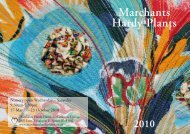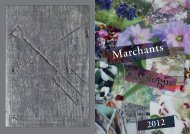download our catalogue free in pdf format here - Marchants Hardy ...
download our catalogue free in pdf format here - Marchants Hardy ...
download our catalogue free in pdf format here - Marchants Hardy ...
Create successful ePaper yourself
Turn your PDF publications into a flip-book with our unique Google optimized e-Paper software.
8<br />
9<br />
CENTAUREA bella. A neat border front plant with silvery evergreen cut foliage and a<br />
generous summer display of lilac-p<strong>in</strong>k flowers. 30cm.<br />
*C. ‘Blewit’. A C. montana hybrid orig<strong>in</strong>at<strong>in</strong>g <strong>in</strong> Turkey with splendid large lilac-blue<br />
‘Cornflowers’. Spr<strong>in</strong>ts about <strong>in</strong> a forgivable sort of way. 30cm.<br />
C. cheiranthifolia. Large flowers the col<strong>our</strong> of real Creme Anglaise. Like the above<br />
– runs about. 30cm.<br />
C. simplicicaulis. As C. bella but a notch smaller <strong>in</strong> all its parts. A very pretty front<br />
l<strong>in</strong>er. 20cm.<br />
CEPHALARIA dipsacoides. In effect, a da<strong>in</strong>tier form of C. gigantea, with smaller<br />
pale yellow flowers emerg<strong>in</strong>g from exquisitely fashioned buds. In w<strong>in</strong>ter, the spacious<br />
tracery of wiry stems and spent seed heads presents a beautiful, though stark silhouette.<br />
2m.<br />
CHAEROPHYLLUM hisutum roseum. A highly effective lilac-p<strong>in</strong>k Cow Parsley<br />
relative and as one famous garden writer puts it ‘– few plants can hold a candle to it <strong>in</strong><br />
May’. 70cm.<br />
*CHAMERION (EPILOBIUM) angustifolium ‘Stahl Rose’. So how brave are you?<br />
Feel<strong>in</strong>g wild? The prettiest form of Rose-Bay Willow herb we th<strong>in</strong>k, pale p<strong>in</strong>k with<br />
crimson calyxes. Delicious – but how it runs<br />
CHRYSANTHEMUM. Useful plants for the cutt<strong>in</strong>g garden or border alike.<br />
C. ‘Chelsea Physic Garden’. Coppery-russet orange flowers creat<strong>in</strong>g the effect of a<br />
multi quilled Sea Urch<strong>in</strong>.<br />
C. ‘Cottage Apricot’. S<strong>in</strong>gle flowers, a beautiful shade for autumn of apricot-orange<br />
fad<strong>in</strong>g to an apricot-p<strong>in</strong>k. 70cm.<br />
C. ‘Kle<strong>in</strong>e Eisbar’. Double, the layered ray petals on open<strong>in</strong>g are sta<strong>in</strong>ed yellow. These<br />
unfold to show off pure white flowers with a yellow button eye. 60cm<br />
C .‘Weisse W<strong>in</strong>teraster’. Similar to the above but at 45cm a little shorter.<br />
CLEMATIS ex ‘Cote d’Azur’. A boldly spread<strong>in</strong>g, leafy herbaceous plant often<br />
col<strong>our</strong><strong>in</strong>g well <strong>in</strong> Autumn. The tubular violet-blue flowers are not large but generously<br />
born. Good seed heads are an added bonus. 1m.<br />
*CONVOLVULUS cneorum. First rate silky, silver leaved hummock form<strong>in</strong>g shrub<br />
for a well dra<strong>in</strong>ed hot spot. Pleated, large white flowers throughout summer and<br />
autumn. 60cm x 120cm.<br />
*C. mauritanicus. (syn. Sabatius) A spread<strong>in</strong>g plant provid<strong>in</strong>g an ebb and flow of<br />
sat<strong>in</strong> like pearly blue salvers through summer/autumn. A desert island plant for us<br />
and capable of a long life <strong>in</strong> a sheltered spot. 15cm.<br />
*C. m. ‘Dark Form’. Much darker but with smaller flowers than the above.<br />
CORYDALIS solida var. solida ‘George Baker’. A legendary plant orig<strong>in</strong>ally from the<br />
woodland floor of Transsylvania. This form (which grows as a tuber) has glow<strong>in</strong>g deep<br />
coral p<strong>in</strong>k flowers and likes a quiet half shaded spot <strong>in</strong> the garden. 15cm.<br />
CROCOSMIA. We can th<strong>in</strong>k of no better way to enliven the late summer border than<br />
to use these dazzl<strong>in</strong>g performers. They love moisture (not boggy) and lots of sunsh<strong>in</strong>e to<br />
perform well, and need divid<strong>in</strong>g every now and then to keep them <strong>in</strong> good fettle.<br />
*C. ‘Castle Ward Late’. The orangey-red segments are narrower than most, giv<strong>in</strong>g the<br />
plant a spidery look. 80cm<br />
£4.60<br />
£4.85<br />
£4.85<br />
£4.60<br />
£4.75<br />
£4.75<br />
£5.25<br />
From<br />
£4.80<br />
£5.25<br />
From<br />
£4.90<br />
£4.35<br />
£4.35<br />
£4.00<br />
From<br />
£4.85<br />
CROCOSMIA ‘Gerbe D’or’. Bronze foliage acts as a great backdrop to pale orange<br />
flowers. A reliable, hearty grower. 70cm.<br />
C. ‘Late Lucifer’. Similar to the above, but 2 weeks later. Marvellous <strong>here</strong> <strong>in</strong> partial<br />
shade with Purple Hazel. A Great Dixter selection but slow we f<strong>in</strong>d.<br />
C. ‘Lucifer’. Aptly named devilish red flowers partner superb ribbed foliage. Common<br />
but oozes class. 1.5m.<br />
*C. masoniorum ‘Dixter Flame’. C. Lloyd’s answer to the Lucifer look alikes, pure<br />
red, broad leaves and an accommodat<strong>in</strong>g 70cm <strong>in</strong> height.<br />
C. m. ‘Rowallane Yellow’. No bend<strong>in</strong>g required as the solid yellow flowers are upward<br />
fac<strong>in</strong>g Handsome broad foliage too. 90cm.<br />
*C. ‘Queen Alexandra’. Elegant, nodd<strong>in</strong>g Erythronium like orange blooms enhanced<br />
by a dash of crimson <strong>in</strong> the throat. 80cm.<br />
*C. ‘Severn Sunrise’. Almost everyone comments fav<strong>our</strong>ably on the weird peachy-rose<br />
col<strong>our</strong> of this award w<strong>in</strong>n<strong>in</strong>g plant. A challenge to place this col<strong>our</strong> well but terrific<br />
with purples. 60cm.<br />
CYCLAMEN coum. The form we offer has good silvery leaves and purple magenta<br />
flowers <strong>in</strong> w<strong>in</strong>ter. Available <strong>in</strong> autumn 2013.<br />
*DAHLIA cocc<strong>in</strong>ea. Seed raised plants from an isolated plant of the true species. Fresh<br />
green foliage compliments the slightly nodd<strong>in</strong>g, Clement<strong>in</strong>e sized pale orange flowers.<br />
1.2m +.<br />
*D. x cocc<strong>in</strong>ea. Flower<strong>in</strong>g sized seedl<strong>in</strong>gs from <strong>our</strong> super tanger<strong>in</strong>e orange parent plant.<br />
The progeny vary a little <strong>in</strong>clud<strong>in</strong>g soft reds but we’ve yet to see a dull one among<br />
them.<br />
Dahlia x Cosmos. We harvested what looks like fertile seed from <strong>our</strong> newly acquired<br />
plant. This possesses chocolaty purple red flowers. Heavens knows what the<br />
seedl<strong>in</strong>gs will be like (if they germ<strong>in</strong>ate).<br />
DATISCA cannab<strong>in</strong>a. A tough perennial whose woody stems annually atta<strong>in</strong> 2m +,<br />
decked with attractive, slender cannabis like leaves (if you happen to know about these<br />
th<strong>in</strong>gs). T<strong>in</strong>y green flowers hang <strong>in</strong> tassels <strong>in</strong> late summer contribut<strong>in</strong>g splendidly to the<br />
green theme.<br />
*DIANTHUS carthusianorum. The form we offer is not as tall as some forms we have<br />
seen, but owns the same grassy foliage and dazzl<strong>in</strong>g bursts of brilliant magenta p<strong>in</strong>k<br />
flowers through summer.<br />
*D. deltoides ‘Leuchtfunk’. Saturated crimson flowers, like splashes of blood over a<br />
mat of deep green foliage.<br />
DIASCIA ‘Emma’. Narrow leaved sucker<strong>in</strong>g clumps and a profusion of dusky deep<br />
p<strong>in</strong>k flowers – exactly what we expect of these marvellous, hardy plants. 30cm.<br />
D. fetcaniensis. Showy big spurred flowers, mid p<strong>in</strong>k. The foliage is noticeably hairier<br />
than others. 30cm.<br />
D. personata. A remarkable newcomer hold<strong>in</strong>g itself, literally, head and shoulders<br />
above its k<strong>in</strong> with its lofty, upright habit. Typical horned mid-p<strong>in</strong>k flowers for<br />
months and months. South Africa. 60cm.<br />
DICTAMNUS albus. The res<strong>in</strong>ous, aromatic Dittany of Crete <strong>in</strong> its orchid like,<br />
glisten<strong>in</strong>g white form. Slow we f<strong>in</strong>d but worth the wait and once settled a long lived<br />
plant. 90cm eventually.<br />
From<br />
£4.85<br />
£3.25<br />
£5.00<br />
From<br />
£5.00<br />
From<br />
£4.75<br />
£5.50<br />
£4.60<br />
£4.60<br />
£4.65<br />
£4.65<br />
£4.65<br />
£5.00





